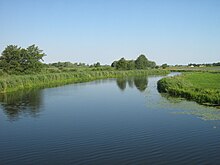Mecklenburg-Western Pomerania border valley
The Mecklenburgisch-Vorpommersche Grenztal , also known as Mecklenburgisch-Pommersches or Mecklenburgisches Grenztal , is a contiguous flat valley landscape in Mecklenburg-Vorpommern . The state border between Mecklenburg and Pomerania ran through this until the 20th century . It is a glacial valley running from south-east to north-west , which at the end of the Vistula Ice Age transported the melt water to the Baltic Sea .
The border valley begins northeast of the Mecklenburg town of Friedland , runs through the valley of the Landgraben and continues at Klempenow in the lower valley of the Tollense . From Demmin the lower Trebel valley to Tribsees belongs to the border valley, from where it continues to Bad Sülze . There it extends through the lower Recknitz valley , with which it ends at Ribnitz-Damgarten in the Ribnitzer See .
The border valley led away the melt water from the Haff reservoir . With the decline in glaciation, this function was taken over by the lower Peene valley and the upper Trebel valley, most recently by Ziese and Ryckgraben . The Peene valley and the upper Trebel valley are directly connected to the border valley near Demmin. The rivers that drain today over the former glacial valleys partly flow in the opposite direction to the meltwater flows. This affects the eastern Landgraben, the Trebel and the Peene Valley. A valley watershed runs between the river systems of the Peene-Trebel and the Recknitz .
After the end of the Vistula Ice Age, large-scale fens formed in the valleys , later also occasional raised bogs such as the Grenztalmoor ( rough moor ) between Bad Sülze and Tribsees. In the past centuries the valley areas were used by the local population as grassland for livestock farming. In addition, extensive renovation work was carried out in places . The peat formed in the peat soils was also used as fuel. Since the 1990s, more than 30 square kilometers of moorland have been funded by the EU and rewetted as planned through moor protection projects of the state of Mecklenburg-Western Pomerania.
The moored valleys are important as biotope network axes between the back country of the Mecklenburg Lake District and the Baltic Sea beyond the region. The Trebel valley, the Peene valley and the lower reaches of the Recknitz are classified as fauna-flora habitats and bird sanctuaries .
Individual evidence
- ^ Dierk Michaelis, Manuela Schult: Trebeltal near Kirch-Baggendorf . In: Greifswalder Geographical Works . Vol. 30, Ernst-Moritz-Arndt-Universität Greifswald, 2003, ISBN 3-86006-215-8 , p. 61

